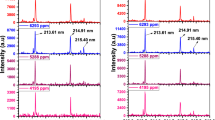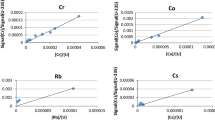Abstract
We successfully developed an optimized fast detection system based on an orthogonal double-pulse laser-induced plasma spectroscopy (ODPLIPS) system for quantitative analysis of valuable heavy metals like vanadium (V) and nickel (Ni) content in fuel power plant residue (PPR). The goal of this study was to investigate the existence of precious elements locally found in nine different kinds of fuel power plant residues and to pay attention to the mining industry towards exploration recycling of these reserves. Those metals were taken from the PPR as a solid waste residue for industrial recycling. The investigated composition analysis by employing the calibration of the LIPS scheme is established on the registered collection spectra of the plasma flare generated by the laser beam in air pressure. We prepared standard matrices in a known concentration in the PPR sample to draw the standard calibration curves for each element, as well as by utilizing a tactic based on the intense lines emission of the elements of interest as quantitative analysis. Those precious elements that exist in the PPR were exactly identified using the energy dispersive X-ray (EDX) and an orthogonal double-pulse-LIPS (ODPLIPS) systems. A combination of UV-NIR lasers of our double-pulse (DP-LIPS) system was employed under a similar adjustment condition to raise the signal-to-noise (SNR) ratio relative to the single-pulse (SP-LIPS) scheme. Several measurements were widely adjusted to elongate the plasma lifetime and to improve the sensitivity of the 266–1064 nm spectra. To overcome the difficulty of insufficient sensitivity in the SP-LIPS or CFLIPS manner for identification of the sample and to achieve a larger atomized mass, larger emitting volume, higher plasma temperature, and a lower detection limit, a double-pulse variant for vaporization of the sample were applied in our study. By using the ODPLIPS excitation technique, the intensity of both spectral lines Ni(II) 221.65 and V(II) 294.45 nm were enhanced by nearly 4 and 5 times, respectively at laser pulse energy (LPE) ratio (E2/E1 = 3) as compared to the SP signal that could help the analytical performance of the LIPS system in terms of increasing sensitivity and reducing self-absorption effects for PPR pellets. The preferable of the ODPLIPS scheme over the SP-LIPS scheme results from the suppression of molecular bands and improving the relative intensity of the spectral lines, which makes it favorable for enhancing the sensitivity of the LIPS determination in PPR. Several experimental parameters of ODPLIPS geometry like the periodic interval between the data acquisition and the excitation pulse laser (ICCD gate delay, td = 200 ns), the LPE ratio (E2 = 3 times E1) and the inter-pulse separation between the couple laser pulses (Δt = 800 ns) have been optimized to improve the SNR and sensitivity of our detection system and to achieve the best detection limit. For better understanding, the basis of the measured LIPS signal enlargement, the spatial evolution of the plasma temperature and density along the direction of the plasma plume expansion of the separated distance from the pressed sample surface was also measured for both SP-LIPS and ODPLIPS schemes. The calibration curves were employed to quantify the Ni and V concentration that exists in the PPR samples. Furthermore, the LIPS outcome accuracy in evaluating the V and Ni concentration in PPR was validated using an inductively coupled plasma-optical emission spectrometry (ICP-OES) system. The predicted LIPS outcomes were found in complete harmony with the ICP-OES outcomes. The predictable limit of detection of our ODPLIPS system for V and Ni heavy metals was observed to be about 12.58, and 14.75 mg/kg, respectively. The proposed protocols elucidated that the brilliant profit of ODPLIPS for identifying valuable V and Ni metals present in the PPR sample and for examining the quality and purity of recovering metal manufactures.
Graphic Abstract










Similar content being viewed by others
References
Geankoplis, C.J.: Transport Process, and Unit Operations, 3rd edn, pp. 144–725. The University of Minnesota, New York (1993)
Grisafi, F., Brucato, A., Rizzuti, L.: Solid-liquid transfer coefficients in gas-liquid-solid system agitated vessels. Can. J. Chem. Eng. 76, 446–455 (1998)
Kim, H., Moon, G., Choi, I., Lee, J., Jyothi, R.K.: Hydrometallurgical process development for the extraction, separation and recovery of vanadium from spent desulfurization catalyst bio-leach liquors. J. Clean. Prod. 187, 449–458 (2018)
Wu, W., Wang, C., Bao, W., Li, H.: Selective reduction leaching of vanadium and iron by oxalic acid from spent V2O5-WO3/TiO2 catalyst. Hydrometallurgy 179, 52–59 (2018)
Khalil, A.A.I.: Development of double-pulse lasers ablation system for generating gold ion source under applying an electric field. Opt. Laser Technol. 75, 105–114 (2015)
Khalil, A.A.I., Morsy, M.A., El-Deen, H.Z.: Development of double-pulse lasers ablation system and electron paramagnetic resonance spectroscopy for direct spectral analysis of manganese doped PVA polymer. Opt. Laser Technol. 96, 227–237 (2017)
Khalil, A.A.I.: A comparative spectroscopic study of single and dual pulse laser produced UV tin plasmas. Opt. Laser Technol. 45, 443–452 (2013)
Khalil, A.A.I., Morsy, M.A.: Quantitative determination of copper in a glass matrix using double pulse laser induced breakdown and electron paramagnetic resonance spectroscopic techniques. Talanta 154, 109–118 (2016)
Tsai, S.L., Tsai, M.S.: A study of the extraction of vanadium and nickel in oil-fired fly ash. Conserv. Recycl. 22, 163–176 (1998)
Stas, J., Dahduh, A., Al-chayah, O.: Recovery of vanadium, nickel and molybdenum from fly ash of heavy oil-fired electrical power station. Chem. Eng. 51, 67–70 (2007)
Tsuboi, I., Kasai, S., Kunugita, E., Komosawa, I.: Recovery of gallium and vanadium from coal fly ash. J. Chem. Eng. 24, 15–20 (1991)
Peng, J., He, Y., Zhao, Z., Jiang, J., Zhou, F., Liu, F., Shen, T.: Fast visualization of distribution of chromium in rice leaves by reheating dual-pulse laser-induced breakdown spectroscopy and chemo metric methods. Environ. Pollut. 252, 1125–1132 (2019)
Khalil, A.A.I., Richardson, M., Barnett, C., Johnson, L.: Double pulse UV laser induced breakdown spectroscopy of stainless steel. J. Appl. Spectrosc. 73, 735–742 (2006)
Said, M., Cassayre, L., Dirion, J.L., Joulia, X., Nzihou, A.: Effect of nickel impregnation on wood gasification mechanism. Waste Biomass Valoriz. 8, 2843–2852 (2017)
Maurmann, S., Kadetov, V.A., Khalil, A.A.I., Kunze, H.-J., Czarnetzki, U.: Thomson scattering in low temperature helium plasmas of a magnetic multipole plasma source. J. Phys. D 37, 2677–2682 (2004)
Khalil, A.A.I., Hafez, A.A., Abd El-Alem, M.A., Khalil, E.M.: Characterization the level of a new low-cost adsorbent material prepared from date palm kernel pits via DP-LIBS and ICP-OES spectroscopic techniques. Environ. Sci. Pollut. Res. 26, 20753–20768 (2019)
Change, J.J., Warner, B.E.: Laser-plasma interaction during visible-laser ablation of methods. Appl. Phys. Lett. 69, 473–479 (1996)
Khalil, A.A.I., Gandoll, M.A., Destegaar, M.A.: Detection of trace elements in nonorganic spent clay waste using optimized dual pulsed laser induced breakdown spectrometer. Appl. Opt. 53, 1709–1717 (2014)
Chumakov, A.N., Bosak, N.A., Ivanov, A.A.: Near-surface plasma formed by dual-pulse laser action at two wavelength on titanium in air. J. Appl. Spectrosc. 86, 836–842 (2019)
Forster, G.D., Lewis, L.J.: Numerical study of double-pulse laser ablation of Al. Phys. Rev. B 97, 1–17 (2018)
Wang, Y., Chen, A., Wang, Q., Zhang, D., Li, S., Jiang, Y., Jin, M.: Study of signal enhancement in collinear femtosecond-nanosecond double-pulse laser-induced breakdown spectroscopy. Opt. Laser Technol. 122, 1–6 (2020)
Coons, R.W., Harilal, S.S., Hassan, S.M., Hassanien, A.: The importance of longer wavelength reheating in dual-pulse laser-induced breakdown spectroscopy. Appl. Phys. B 107, 873–880 (2012)
Tognoni, E., Cristoforetti, G.: Basic mechanisms of signal enhancement in ns double-pulse laser-induced breakdown spectroscopy in a gas environment. JAAS 29, 1318–1338 (2014)
Babushok, V.I., DeLucia, F.C., Gottfried, J.L., Munson, C.A., Miziolek, A.W.: Double pulse laser ablation and plasma: laser-induced breakdown signal enhancement. Spectrochim. Acta B 61(9), 999–1014 (2006)
Lu, Y., Zorba, V., Mao, X., Zheng, R., Russo, R.: UV fs-ns double-pulse laser induced breakdown spectroscopy for high spatial resolution chemical analysis. J. Anal. At. Spectrum. 28, 743–748 (2013)
Scaffidi, J., Angel, S.M., Cremers, D.A.: Emission enhancement mechanisms in dual-pulse LIBS. Anal. Chem. 78(1), 24–32 (2006)
Khalil, A.A.I., Labib, O.A.: Detection of micro-toxic elements in commercial coffee brands using optimized dual-pulsed laser-induced spectral analysis spectrometry. Appl. Opt. 23, 6729–6741 (2018)
Noll, R.: Laser-Induced Breakdown Spectroscopy-Fundamentals and Applications. Springer, Heidelberg (2012)
McWhirter, R.W.P.: In plasma diagnostic techniques. In: Huddlestone, R.H., Leonard, S.L. (eds.) Chapter 5, pp. 206–465. Academic Press, New York (1965)
Khalil, A.A.I., Gondal, M., Al-Mokbil, G.: Laser wavelength and argon ambient gas pressure effects on metallic plasma emission. J. Appl. Spectrosc. 85, 592–599 (2018)
NIST: Atomic spectra database, USA. https://www.nist.gov/physlab/data/asd.cfm (2019)
Gordillo-Vazquez, F.J., Perea, A., McKiernan, A.P., Afonso, C.N.: Electronic temperature and density of the plasma produced by nanosecond ultraviolet laser ablation of LiF. Appl. Phys. Lett. 86, 1–3 (2005)
Griem, H.R.: Principles of Plasma Spectroscopy. Cambridge University Press, Cambridge (1997)
Konjevic, N., Lesage, A., Fuhr, J.R., Wiese, W.L.: Experimental stark widths and shifts for spectral lines of neutral and ionized atoms, a critical review of selected data for the period 1989 through 2000. J. Phys. Chem. Ref. Data 31, 819–927 (2002)
Takahashi, T., Thornton, B.: Quantitative methods for compensation of matrix effect and self-absorption in laser induced breakdown spectroscopy signals of solids. Spectrochimica Acta B 138, 31–42 (2017)
Kunze, H.-J.: Introduction to Plasma Spectroscopy. Springer Series on Atomic, Optical, and Plasma Physics. Springer, Heidelberg (2009)
Anisimov, S.I., Luk’yanchuk, B.S., Luches, A.: An analytical model for three-dimensional laser plume expansion into vacuum in hydrodynamic regime. Appl. Surf. Sci. 96, 24–32 (1996)
Haq, S.U., Ahmat, L., Mumtaz, M., Shakeel, H., Mahmood, S., Nadeem, A.: Spectroscopic studies of magnesium plasma produced by fundamental and second harmonics of Nd:YAG laser. Phys. Plasmas 22, 1–7 (2015)
Gilligan, R., Nikoloski, A.N.: The extraction of vanadium from titanomagnetites and other sources. Miner. Eng. 146, 1–18 (2020)
Ilyas, S., Srivastava, R.R., Kim, H., Ilyas, N., Sattar, R.: Extraction of nickel and cobalt from a laterite ore using the carbothermic reduction roasting-ammoniacal leaching process. Sep. Purif. Technol. 232, 1–8 (2020)
Messaggi, M., Rabissi, C., Gambaro, C., Meda, L., Gasalegno, A., Zago, M.: Investigation of vanadium redox flow batteries performance through locally-resolved polarization curves and impedance spectroscopy: insight into the effects of electrolyte, flow field geometry and electrode thickness. J. Power Sources 449, 1–9 (2020)
Rai, N.K., Rai, A.K.: LIBS—an efficient approach for the determination of Cr in industrial waste water. J. Hazard Mater. 150, 835–838 (2008)
Cristoforetti, G., Tognoni, E., Gizzi, L.A.: Thermodynamic equilibrium states in laser-induced plasmas, from the general case to laser-induced breakdown spectroscopy plasmas. Spectrochim. Acta B 90, 1–22 (2013)
Tognoni, E., Cristoforetti, G., Legnaioli, S., Palleschi, V.: Calibration-free laser-induced breakdown spectroscopy. State of the art. Spectrochim. Acta B 65, 1–14 (2010)
Peiro, S., Luengo, E., Segovia, F., Raso, J., Almajano, M.P.: Improving polyphenol extraction from lemon residues by pulsed electric fields. Waste Biomass Valoriz. 10, 889–897 (2019)
Shrivastava, A., Gupta, V.B.: Methods for the determination of limit of detection and limit of quantification of the analytical methods. Chron. Young Sci. 2, 21–25 (2011)
Miziolek, A., Palleschi, V., Schechter, I.: Laser-Induced Breakdown Spectroscopy (LIBS): Fundamentals and Applications. Cambridge University, Cambridge (2006)
Acknowledgements
The authors are grateful to the National Institute of Laser Enhanced Sciences (NILES), Cairo University, Giza, Egypt, the Main Chemistry Laboratory, the Egyptian Electricity Holding Company, Ministry of Electricity, Cairo, Egypt, and the University of Central Florida (UCF) Laser Laboratories, USA for the financial assistance to acquire the necessary laboratory equipment.
Author information
Authors and Affiliations
Corresponding author
Additional information
Publisher's Note
Springer Nature remains neutral with regard to jurisdictional claims in published maps and institutional affiliations.
Rights and permissions
About this article
Cite this article
Khalil, A.A.I., Hafez, A.I., Razek, T.A. et al. Characterization of Power Plant Residue Using Various Spectroscopic Techniques for Recycling Valuable Metals. Waste Biomass Valor 11, 4649–4665 (2020). https://doi.org/10.1007/s12649-020-01038-w
Received:
Accepted:
Published:
Issue Date:
DOI: https://doi.org/10.1007/s12649-020-01038-w




